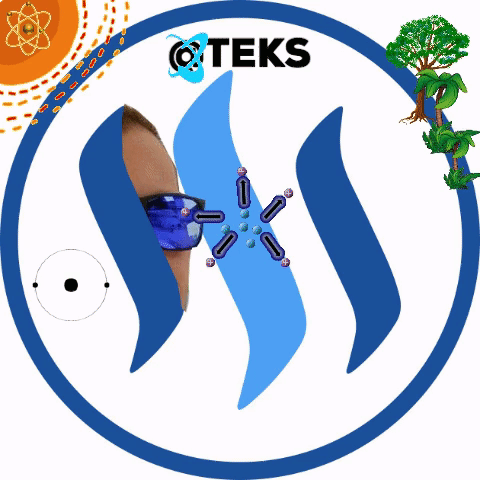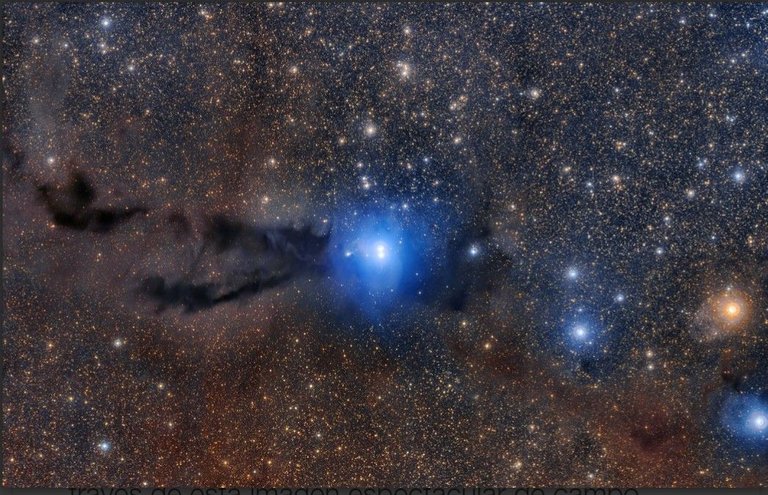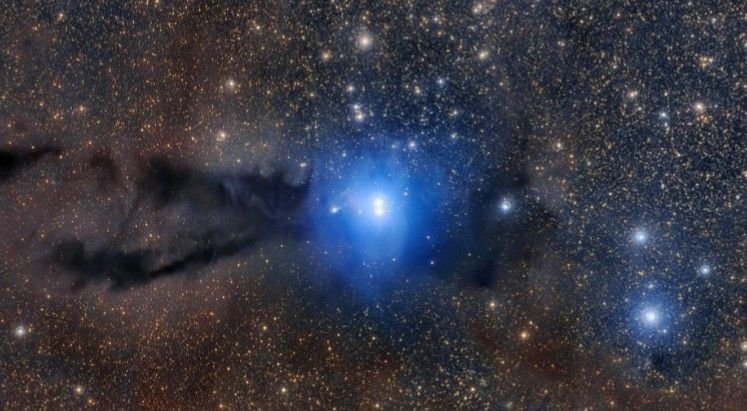The dark nebulae also called absorption nebulae are regions of space filled with gas and dust, which can reach a size of hundreds of light years. But what gives them the name "dark" is because they don’t let out the light of the stars they contain.
1 - Image of Lupus 3 taken using the VLT Survey Telescope and the MPG/ESO 2.2-metre telescope. - Credits: ESO
When we look at the Milky Way from the earth with the naked eye, we find some very dark regions that contrast with the glare of the other regions of our galaxy. It is possible that you have seen some of these dark nebulae without realizing it, since some are appreciated without the need to use a telescope. The most famous are the "Great Rift" and the "Coalsack Nebula".
Although it may seem that in these dark regions nothing happens, that they are cold and empty regions of inert space. Nothing is further from reality, these regions are very active regions in the creation of stars just like the brights nebulae. But instead of being bright clouds of gas like their nebulae sisters, these dense clouds do not allow the light of the stars inside them to be visible.
”Lupus 3 has an irregular form, appearing like a misshapen snake across the sky. In this image it is a region of contrasts, with thick dark trails set against the glare of bright blue stars at the centre. Like most dark nebulae, Lupus 3 is an active star formation region, primarily composed of protostars and very young stars. Nearby disturbances can cause denser clumps of the nebula to contract under gravity, becoming hot and pressurised in the process. Eventually, a protostar is born out of the extreme conditions in the core of this collapsing cloud.”
Q1 - eso1804
2 - Extended Image of Lupus 3 - Credits: ESO
If we look at the photograph recently made by the European Space Agency of the Southern Observatory (ESO), we can see two very bright blue stars in the center of the image. These two stars have reached enough size to be able to interact with the gas cloud and allow us to see its light.
”Early in their lives, the radiation they emitted was largely blocked by the thick veil of their host nebula, visible only to telescopes at infrared and radio wavelengths. But as they grew hotter and brighter, their intense radiation and strong stellar winds swept the surrounding areas clear of gas and dust, allowing them to emerge gloriously from their gloomy nursery to shine brightly.”
Q2 - eso1804
The nebulae, the regions of space where new stars are formed and also the stellar cemeteries. Regions of space that leave no one indifferent, either because of its beautiful brightness or its disturbing darkness. All of them are a source of information, so important that they help us to understand how this region of space was thousands of millions of years ago before our Sun was formed and therefore our entire solar system.
References
Q1, Q2, 1, 2 - eso1804 — Photo Release
https://www.eso.org/public/unitedkingdom/news/eso1804/?lang

Gift-thanks to @markperandin
Let's take care of the pale blue dot
Enjoy your day. Enjoy your life.

Gift-thanks to @stellabelle


Very good article... make me want to explore more about this dark nebulae.... like how dense and what difference with another nebulae....
I'm glad that this post has fostered your curiosity.
Thank you very much.
What is this sir
Pretty good and beaitiful thanks for sharing
@echowhale team swimming by with your upvote
Congratulations! This post has been upvoted from the communal account, @minnowsupport, by teks from the Minnow Support Project. It's a witness project run by aggroed, ausbitbank, teamsteem, theprophet0, someguy123, neoxian, followbtcnews, and netuoso. The goal is to help Steemit grow by supporting Minnows. Please find us at the Peace, Abundance, and Liberty Network (PALnet) Discord Channel. It's a completely public and open space to all members of the Steemit community who voluntarily choose to be there.
If you would like to delegate to the Minnow Support Project you can do so by clicking on the following links: 50SP, 100SP, 250SP, 500SP, 1000SP, 5000SP.
Be sure to leave at least 50SP undelegated on your account.
This post has received a 1.92 % upvote from @boomerang thanks to: @teks
Hi, I found some acronyms/abbreviations in this post. This is how they expand:
nice